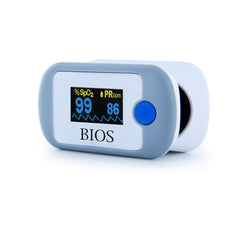3 Important Health Products for Monitoring At Home
As the second COVID-19 wave spreads across the country, many Canadians are either locked-down or in self imposed quarantines. The consequence is significantly fewer medical appointments and trips to emergency. If you become ill, contacting your healthcare provider for guidance is often the first step, and providing some self-measured data can be critical in helping them assess your condition.

Body Temperature
Our bodies naturally respond to the presence of a virus by raising our body temperature – a fever. While it is not fully understood what percentage of people infected with COVID-19 are asymptomatic, everyone with severe infections exhibit common symptoms including: FEVER, cough, loss of taste/smell, fatigue etc.
Many people fail to realize is that body temperature varies by individual and by location of where the measurement is taken. For instance, ear temperatures tend to be 0.3°C – 0.6°C higher than oral measurements. Therefore, it is important to take each family members’ temperature when they are healthy, so a fever is easily identifiable.
Fever thermometers range from simple “stick-type” digital models which can be found for as little as $10 -$20; to faster, more sophisticated and less intrusive Forehead and Ear Thermometers that cost $70 - $100.
Using a fever thermometer is a strong confirmation you have an infection. A Covid-19 test will determine the presence of the COVID-19 virus, or a different infection like the flu.

Blood Pressure
People with high blood pressure (hypertension) have a higher risk of getting ill when confronted with COVID-19. Early studies have identified that people with hypertension are infected more frequently with COVID-19 and the cases are generally more severe. Research from Italy indicated that 76% of people infected with COVID-19 had hypertension and had a 2.5 times greater risk of severity and mortality(1).
During the pandemic, while visits to clinics and person-to-person contact are limited, it is especially important for people with hypertension to measure their blood pressure at home. It is the only way to confirm that antihypertensive medication(s) are working and your BP is being managed. Uncontrolled blood pressure is the primary factor in cardiovascular events such as heart attack and stroke.
When measuring your blood pressure at home, it is important to employ proper techniques (see video) and take readings at the appropriate times of day. Hypertension Canada recommends first thing in the morning, before breakfast and in the evening, two hours after dinner.
Home blood pressure monitors can be purchased at pharmacies or on-line. Shoppers should look for products recommended by Hypertension Canada. Monitors range in price from $70 to $150, depending on their features and diagnostic capabilities.

Blood Oxygen Saturation
A Finger-Tip Pulse Oximeter measures blood oxygen saturation or SpO2. The measurement is quick and painless. The device uses two frequencies of light (red and infrared) to determine the percentage of hemoglobin in the blood. (Oxygen binds to hemoglobin in red blood cells in our lungs and then is pumped throughout the body). Light emitting diodes project through the finger and the hemoglobin absorbs different amounts of the light depending on the amount of oxygen present.
A pulse oximeter is an important device for people with chronic respiratory conditions such as COPD, asthma, lung cancer and heart issues that impede the delivery of oxygenated blood through the body. People with lung issues may not be getting enough oxygen through regular breathing. The SpO2 percentage is an indication that supplemental oxygen may be required.
An oxygen saturation level > 95% is normal for most healthy people. A level of 92% indicates potential hypoxemia when not enough oxygen is being circulated through the body. Pulse oximeter readings below 90% are serious and normally require supplemental oxygen.
COVID-19 is a respiratory infection that can deteriorate into pneumonia and lower SpO2 levels. British researchers analyzing COVID-19 outcomes found that if oxygen saturation fell to 94% or 93%, mortality increased to 13%, and if it fell lower, the risk of mortality increased to 28%. Some patients experienced oxygen levels dropping without obvious symptoms like shortness of breath(2).
The important point for everyone to remember is that people with respiratory conditions, who are at a high risk of developing serious COVID-19 symptoms, can benefit from self monitoring their oxygen saturation levels. If one’s SpO2 % drops quickly, or falls below 95%, one would be well advised to contact a healthcare provider for next steps and treatment.
Finger Tip Pulse Oximeters are available at most pharmacies and on-line for about $60.
Self-monitoring is a new reality for most of us. The medical devices described in this article are readily available, they are accurate and can provide important diagnostic information that should be shared with a medical professional if you believe you are at risk, or your condition is deteriorating.
Author: Mark Beaton, Sr. VP of Marketing, BIOS Medical
Sources:
- Hypertension and its severity or mortality in Coronavirus disease 2019. Polish Archives of Internal medicine, March 2020
- BMJ 2020; 371: m4151 Covid-19: Patients to use pulse oximetry at home to spot deterioration
- Efficacy of self-monitored blood pressure, with or without telemonitoring, for titration of antihypertension medication (TASMINH4): an unmasked randomized controlled trial. The Lancet Vol 391, issue 10124, p949-959, March 10, 2018
 FR
FR

